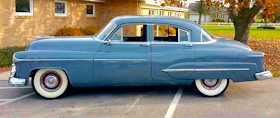In this post, I referenced an article in Special-Interest Autos magazine issue #39 titled "Body Politics" by Richard Howard Stout. It was fascinating to me because it showed the various length and style permutations General Motors was able to attain for its more expensive models.
But there was one potential problem. Stout seems to have been dealing with what now can be seen as C-body variations, yet he calls them B and C bodies. His B-body is a shorter one than what he calls the C-body. Stout is referring to bodies introduced for the 1950 model year. A 1941-vintage B-body was in production through the '49 model year, but its replacement did not appear until 1951, leaving a one-year gap. For that reason it's possible that the base (or "lesser" as I'll call it) C-body was referred to as a B-body by GM staff working on C-bodies, not thinking much about the new B-body under development. (Stout refers to the upcoming B-body as the OB-body, perhaps a term used in General Motors while it was gestating.)
For the 1950 model year those lesser C-bodies are found on Oldsmobile 98s, Buick Specials, about half of Buick Supers, and on Series 61 Cadillacs. At least 626,000 were built, about 54 percent of them Buick's entry-level Special models. The appearance of the new B-body on 1951 Buick Specials meant that the need for lesser C-bodies was greatly reduced. As it happened, around 92,000 (perhaps not counting some hardtop coupes and convertibles whose basis is difficult to identify) were made for the '51 model year. The majority were Olds 98s. No lesser C-body sedans were made thereafter, as best I can tell from the information I have at present.
Below are images of lesser C-body four-door bustle-back sedans. Fastbacks (all were lesser C-bodies) were phased out after the 1950 model year -- an example is shown. Most Gallery images are of for-sale cars.
1950 Buick Special Sedanet - Mecum auction photo
A fastback lesser C-body. There also were 4-door fastback lesser C-body cars.
1950 Buick Special
Lesser C-body sedans are easily identified because they were four-window, featuring a broad C-pillar.
1950 Oldsmobile 98
This is the Oldsmobile version. Other views of this car are shown farther down.
1950 Cadillac 61 - BaT auction photo
Even some Cadillacs used the lesser C-body. But only for Series 61 that was dropped the following model year.
Front quarter view of the Oldsmobile 98.
Rear quarter view.






Looks like the Cadillac and Oldsmobile shared front doors too. And (looked up some photos) all three shared trunk lids too. GM went to a lot of trouble mixing and matching and then convincing buyers they were all different cars. And a lot of trouble inside one brand to use B and C bodies with different fender heights but shared grilles, dashboards, tail lights etc.
ReplyDeleteOf course back then they had their own (or maybe some bits shared with one other brand) frames, suspensions, drive trains etc. A very complicated way to produce five different (sort of) brands.
Thank you for the post. I recall seeing some of these bodies on Buicks and Cadillacs. I never liked them then or now. On the other hand, the six window 1950 to 1956 Senior Buicks and Cadillac sedans (I know the bodies changed for '54) (and the Tri Five Chevy four doors) always looked great to me and still do.
ReplyDelete